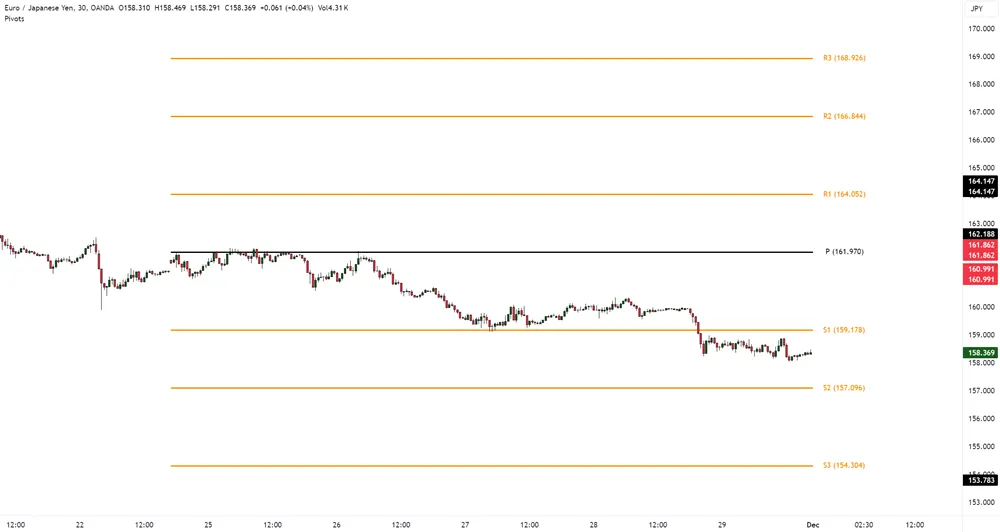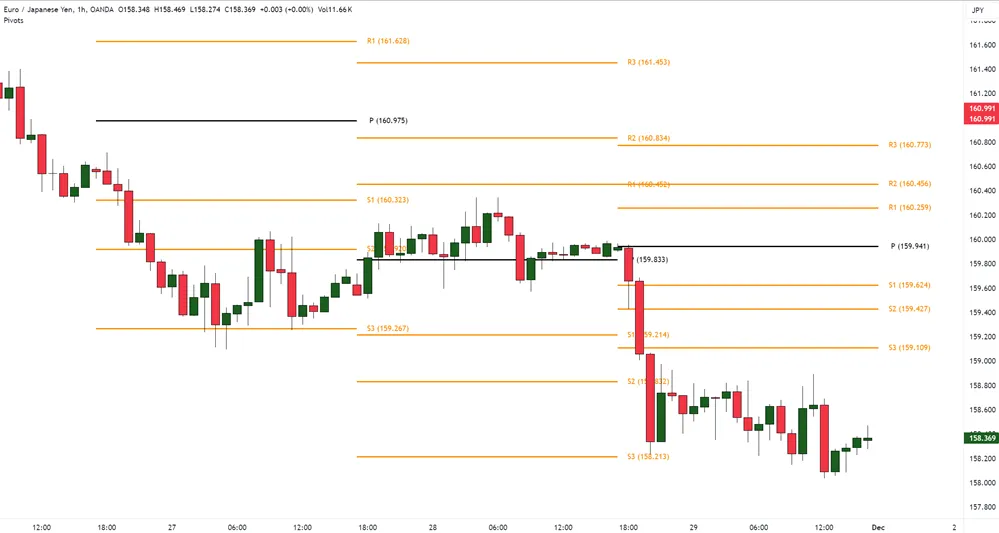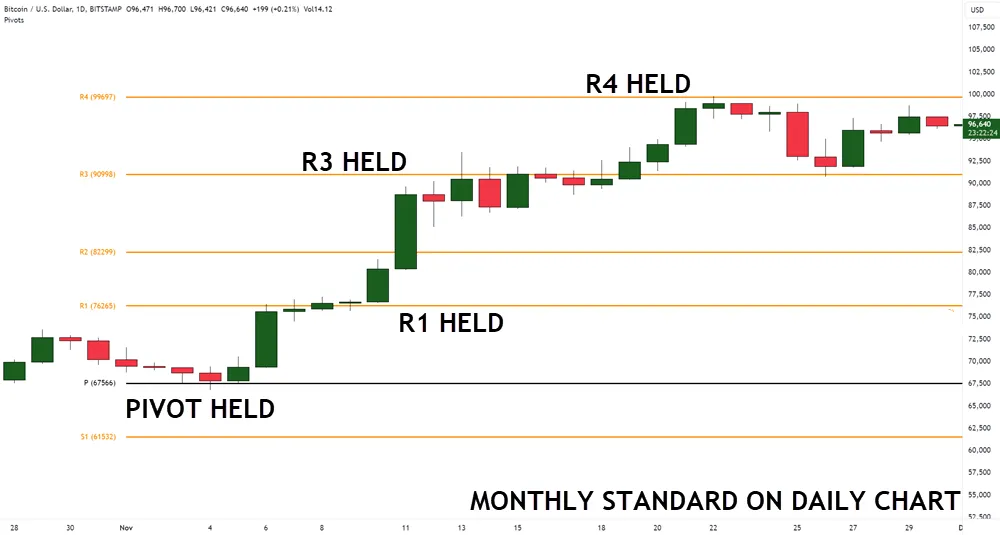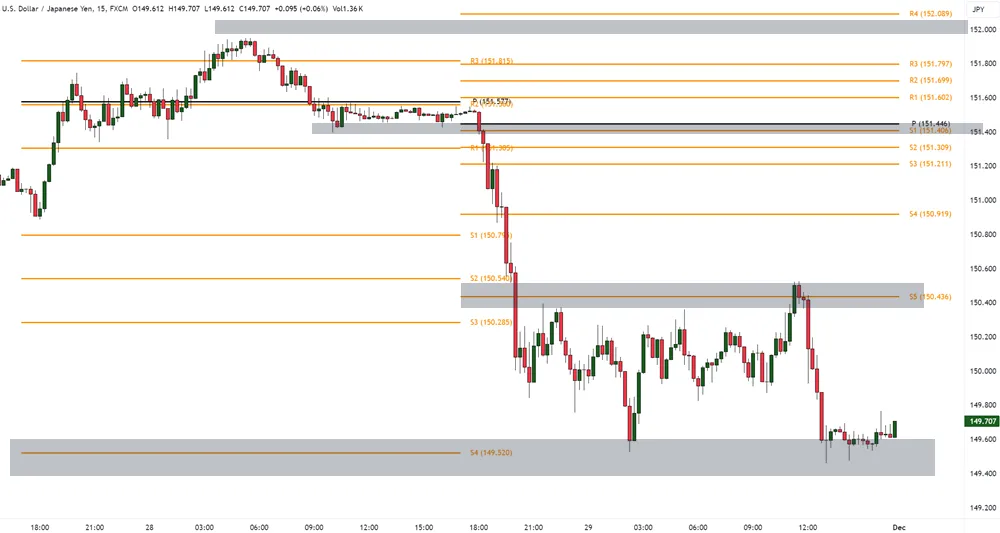If you’ve been looking for a systematic approach to identify potential market turning points, you’ll find pivot point analysis interesting. This method brings mathematical precision to support and resistance levels, offering you clear entry and exit signals while removing much of the subjective guesswork from trading decisions.
By understanding how these strategic price levels work, you’ll gain understanding into where institutional traders often place their orders and how market psychology influences price action. But knowing the basics isn’t enough – there’s a critical element that separates successful pivot traders from the rest.
TLDR
- Pivot Points calculate key support and resistance levels using previous day’s high, low, and closing prices to identify potential market reversals.
- Standard Pivot Point (PP) formula is (High + Low + Close) / 3, with support and resistance levels derived from this base calculation.
- Multiple types of pivot points exist, including Fibonacci, Camarilla, and DeMark, each suited for different trading styles and market conditions.
- Trading strategies typically involve entering positions when price bounces off support or resistance pivot levels with confirming price action.
- Risk management requires setting stop-losses near pivot points and limiting trade exposure to 1-2% of trading capital per position.
What Are Pivot Points
At the core of technical analysis, pivot points are mathematical price levels that help traders identify potential market turning points. These tools serve as reliable indicators by calculating key support and resistance levels based on previous trading sessions. When you’re analyzing market volatility influence, pivot points can help you stay focused on critical price zones.

One of the main pivot point benefits is their ability to provide objective reference points, which positively impacts your trading psychology. Unlike other technical indicators that might seem complex, pivot point tools offer straightforward guidance for your trading decisions. They’re particularly useful when you’re conducting historical performance analysis to validate your strategy.
Pivot points work across different timeframes and markets, making them incredibly adaptable to your trading style. Whether you’re day trading or taking longer-term positions, these levels often act as self-fulfilling prophecies because many traders watch and act on them.
Similar to Fibonacci retracement levels, pivot points help traders identify potential support and resistance areas where price might reverse direction.
Types of Pivot Points
You’ll find several variations of pivot points beyond the standard calculations, including Fibonacci, Camarilla, and DeMark pivot points.
Fibonacci pivot points use the golden ratio to identify additional support and resistance levels, while Camarilla pivot points create eight different price levels to track market movements.
DeMark pivot points take a unique approach by considering whether the previous day’s close was higher or lower than its open, making them particularly useful for trend confirmation.
Fibonacci Pivot Points
Traders looking for advanced precision often gravitate toward Fibonacci pivot points, which incorporate the golden ratio‘s mathematical principles into traditional pivot point calculations. These special pivot points help you identify support and resistance levels using Fibonacci ratios, making them particularly effective during periods of high market volatility.

When you’re developing your entry strategies, you’ll find that Fibonacci pivot points work well with your trading psychology because they provide clear, mathematically-based decision points. You’ll calculate these levels by applying Fibonacci ratios (0.382, 0.618, and 1.618) to the previous day’s trading range. This creates additional support and resistance levels beyond the standard pivot points.
To set your profit targets using Fibonacci pivot points, you’ll want to focus on the key retracement levels. When price approaches these levels, you’ll often notice that other traders are watching them too, which can create self-fulfilling support and resistance zones.
You can use these levels to plan your entries and exits, especially when they align with other technical indicators or price patterns you’re tracking.
The price action confluence strategy can enhance your trading decisions when combined with Fibonacci pivot points by identifying stronger support and resistance zones.
Camarilla Pivot Points
Throughout market hours, Camarilla pivot points can be used as precision-focused tools that divide the previous day’s trading range into eight distinct levels. When you’re dealing with market volatility, these specialized pivot points can help you identify potential reversal zones with greater accuracy.

The Camarilla theory is particularly effective for intraday trading, as it provides more reference points than standard pivot calculations.
Camarilla pivot points work exceptionally well in ranging markets, where price tends to bounce between support and resistance levels. These points are calculated using specific multipliers that create four resistance (R1-R4) and four support levels (S1-S4).
For pivot point accuracy, you’ll want to pay attention to the third and fourth levels (R3, R4, S3, S4), as they often indicate significant potential reversal areas. While they’re primarily used for day trading, you can adapt them to swing trading strategies by applying them to larger timeframes.
The beauty of Camarilla points lies in their ability to provide clear entry and exit signals, making them valuable tools for both novice and experienced traders.
DeMark Pivot Points
DeMark pivot points stand out for their distinctive calculation method that accounts for market open-close relationships. The DeMark methodology takes into account whether the closing price was higher or lower than the opening, making it responsive to market volatility impact.

DeMark pivot points excel in trade execution timing, as they help you identify potential turning points in the market. Unlike other pivot point calculations, they incorporate data from the previous two trading days, which gives you a more comprehensive view of market momentum.
Performance evaluation shows that DeMark points can be especially effective during trending markets.
Understanding pivot point psychology is useful when using DeMark points. If the market closed above its opening price, you’ll use one formula; if it closed below, you’ll use another. This adaptability makes DeMark points particularly useful in volatile markets.
You can combine them with other indicators to confirm potential support and resistance levels, helping you make more informed trading decisions. They’re especially valuable when traditional pivot points aren’t providing clear signals.
Calculating Standard Pivot Points
The calculation of standard pivot points follows a straightforward formula that you can easily master. Understanding pivot point significance begins with knowing the basic components: yesterday’s high, low, and closing prices. When you combine these values, you’ll uncover key pivot point indicators that reveal potential market turning points.

To calculate the main pivot point (PP), simply add the high, low, and closing prices, then divide by three. This forms the foundation of your pivot point strategies and helps you understand pivot point psychology in the markets.
From there, you’ll calculate support and resistance levels using established formulas that highlight pivot point trends.
- PP = (High + Low + Close) / 3
- R1 (First Resistance) = (2 × PP) – Low
- R2 (Second Resistance) = PP + (High – Low)
- S1 (First Support) = (2 × PP) – High
- S2 (Second Support) = PP – (High – Low)
These levels create a framework for your trading decisions, helping you identify potential price reversals and breakout points.
Many traders combine pivot points with the 20-period EMA for enhanced trend identification and trade confirmation.
Understanding Support and Resistance Levels
Support and resistance levels derived from pivot points create a roadmap for your trading decisions. These levels “work” because they reflect market psychology and help you anticipate where prices might bounce or break. When you’re analyzing a chart, you’ll see that prices often respect these predetermined zones, making them valuable for trend analysis.

Think of a support zone as a floor where prices tend to stop falling and potentially reverse upward. You’ll typically find buyers stepping in at these levels, creating natural price bounces.
Resistance levels act like a ceiling, where selling pressure often increases and prices might struggle to move higher. When you spot a resistance breakout, it’s often a signal that buyers have taken control.
What makes these levels useful is how they align with price action throughout the trading day. You’ll find that other traders are watching these same levels, which can create self-fulfilling prophecies.
When price approaches a pivot-based support or resistance level, you’ll want to pay close attention to how it reacts, as this can provide valuable clues about potential trading opportunities.
When broken, these levels often demonstrate a role reversal principle, with former support becoming resistance and former resistance becoming support.
Reading Market Sentiment
Understanding market sentiment through pivot points helps you gauge whether buyers or sellers are in control of price action. When you combine pivot points with behavioral finance principles, you’ll notice how trader emotions often create predictable patterns.
The crowd mentality tends to react strongly at these key levels, making them valuable tools for sentiment analysis. You’ll find that market psychology plays a role when prices approach pivot levels.
These points often trigger emotional responses from traders, leading to potential reversals or breakouts. By watching how prices behave around pivot points, you can better anticipate market movements.
- When price stays above the pivot point, it signals bullish sentiment with strong buyer confidence
- Multiple failed attempts to break below a pivot point suggest strong underlying support
- Quick bounces off pivot levels indicate active participation from major market players
- Volatile price action around pivot points reveals uncertainty in trader emotions
- The distance between price and pivot points helps measure sentiment strength
This approach to reading market sentiment isn’t just about numbers – it’s about understanding how traders collectively react to these important price levels.
Common Trading Setups
Popular pivot point trading setups rely on specific price action patterns that occur around these key levels. As you develop your trading psychology, you’ll notice that prices often react predictably when approaching pivot points, creating opportunities for both momentum strategies and reversal trades.

One common setup involves watching for price consolidation near a pivot level, followed by a breakout in either direction. Your entry timing becomes important here – wait for confirmation of the breakout to avoid false signals during periods of market volatility.
Another reliable setup occurs when price bounces off a pivot support or resistance level with strong momentum, indicating a potential trend continuation.
You’ll want to consider asset correlation when trading these setups, as related markets can provide additional confirmation of your trade idea. For example, if you’re trading forex pairs, watch how other correlated currencies behave around their pivot points.
The most successful traders combine these setups with other technical indicators and always maintain proper risk management. Remember, while pivot points can provide excellent trading opportunities, they work best when market conditions align with your chosen setup.
Risk Management With Pivot Points
When implementing pivot point trading strategies, proper risk management becomes your foundation for long-term success. You’ll need to develop strong trading psychology and emotional discipline to stick to your predetermined risk assessment rules.
Capital preservation should always be your primary focus, as it allows you to stay in the game even during challenging market periods.
- Never risk more than 1-2% of your trading capital on a single trade
- Set clear stop-loss orders at pivot point support or resistance levels
- Keep a detailed trading journal to track your risk-reward ratios
- Maintain consistent position sizing across all your trades
- Have predetermined exit strategies for both winning and losing trades
To improve your loss mitigation efforts, wait for confirmation before entering trades at pivot points.
Don’t rush into positions just because price approaches a pivot level. Instead, watch for additional signals that confirm your trading thesis.
Successful trading isn’t about being right all the time – it’s about managing risk effectively when you’re wrong.
Multiple Timeframe Analysis
Through multiple timeframe analysis, traders can significantly improve their pivot point trading strategy by examining price action across different time horizons. Start by analyzing higher timeframes to identify the main trend, then work your way down to smaller timeframes for precise entry points. This approach helps ensure your trades align with the bigger market picture.
When using these timeframe strategies, you’ll find that trend alignment becomes much clearer. For example, if you spot a potential trade on a 15-minute chart, first check the hourly and 4-hour charts to confirm the overall direction. This trade confirmation process helps you avoid taking positions against the dominant trend – generally low probability setups.
Include volatility assessment in your analysis. Higher timeframes typically show more reliable pivot points, while lower timeframes can help you fine-tune your entries and exits.
Best Practices for Success
Several critical practices can significantly boost your success with pivot point trading. You’ll need to maintain strong trading psychology while adjusting to market volatility and recognizing seasonal trends.
Evaluate your performance regularly and integrate other indicators to confirm your trading signals.
Here are the key practices you’ll want to follow:
- Keep a detailed trading journal to track your decisions and learn from both wins and losses, helping you maintain disciplined trading psychology.
- Monitor market volatility levels before entering trades, adjusting your position sizes and stop-loss levels if needed.
- Combine pivot points with complementary indicator integration, such as moving averages or RSI, to confirm potential trade setups.
- Conduct weekly performance evaluation sessions to review your trades and adjust your strategy as needed.
Start small and gradually increase your position sizes as you gain confidence and experience.
Always test your pivot point strategy thoroughly on historical data before trading with real money, and don’t hesitate to adjust your approach based on changing market conditions.
Your Questions Answered
How Long Should Traders Practice Pivot Points Before Trading With Real Money?
You should practice pivot points for at least 2-3 months using demo accounts before trading real money.
This gives you time to avoid common beginner mistakes and develop proper risk management skills.
Focus on achieving consistent results and psychological readiness during this period.
Don’t rush the process – it’s better to master the strategy in a risk-free environment first.
Can Pivot Points Be Effectively Combined With Price Action Trading Strategies?
Yes, you can effectively combine pivot points with price action trading.
The pivot point significance improves your ability to spot key market levels, while price action collaboration helps confirm potential moves.
When you see candlestick patterns forming near pivot levels, they’ll help with market trend identification and strengthen your entry exit strategies.
Just remember to maintain solid risk management techniques by setting clear stop-losses at these confirmed levels.
Do Pivot Points Work Better in Certain Markets or Specific Trading Sessions?
You’ll find pivot points work particularly well in highly liquid markets like forex and major stock indices, especially during active trading sessions when volume is high.
They’re most effective during the overlap of major market sessions, like London-New York, where you’ll see stronger market trends and clearer price movements.
Your success with pivot points will largely depend on your trader experience and the specific asset classes you’re trading.
What Percentage of Professional Traders Regularly Use Pivot Points in Trading?
While exact statistics vary, research suggests that around 30-40% of professional traders regularly incorporate some type of pivot points into their trading strategy tools.
You’ll find they’re popular among day traders and forex professionals. Many traders combine pivot points with other technical analysis techniques as part of a comprehensive approach. Remember, they are objective and need no subjective interpretation.
It’s worth noting that market indicator usage tends to be higher in forex and futures markets.
Are Pivot Points More Reliable During High-Volatility or Low-Volatility Market Conditions?
Pivot points more reliable during low volatility periods when market trends are more predictable and orderly.
During high volatility, rapid price swings can make pivot levels less dependable as support and resistance.
Your time frame suitability also matters – shorter timeframes work better in calm markets.
Consider trader psychology too; when volatility spikes, emotional trading often overrides technical levels, making pivot analysis less effective.

